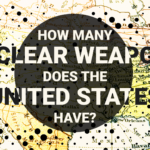Anna Péczeli, and research fellow, Center for Strategic and Defense Studies, National University of Public Service, Budapest, Hungary, affiliate, Stanford University’s Center for International Security and Cooperation, EXPERT COMMENTARY
So far, each post-Cold War US administration has prepared its own Nuclear Posture Review, but the framework and the scope has been different in all cases. In terms of content, however, there are many continuities, and the Trump administration’s strategy did not make a significant departure from the former nuclear reviews. What primarily divides the 2018 NPR from previous such documents is the much “darker” evaluation of the security environment and the future steps the administration is planning to take in response.
Like the Obama administration’s 2010 NPR, the Trump strategy decided to (among other things) maintain the nuclear triad, continue investments in the modernization of US nuclear forces and supporting infrastructure, maintain high alert levels for prompt response to an attack on the US or its allies and partners, continue the forward deployment of US nuclear forces on the territory of allies, preserve the nuclear testing moratorium, maintain the negative security assurance for non-nuclear weapon states, decide against a no-first use policy, try to better integrate conventional and nuclear forces, adhere to the laws of armed conflict in nuclear operations, and finally, recognize that arms control as a principle serves the national interests of the United States. The Trump administration also followed the (positive) example of President Obama in terms of transparency. The 49-page 2010 report on the Obama Nuclear Posture Review was the most substantive write-up that any administration had published. The Trump team issued an even longer (75-page) report on its NPR.
Despite these similarities, the tone of the 2018 Nuclear Posture Review is very different from the 2010 document, and there are important changes in both the details and in main focus areas. One of the primary reasons the Obama posture received strong bipartisan support was its delicate balance between working towards the ultimate goal of a world without nuclear weapons, and in the meantime maintaining a safe, secure, and effective nuclear arsenal. But the 2018 NPR is mostly focused on the second element, and it puts arms control measures in the back seat.
It is true that the international security environment has changed for the worse since 2010. But the new NPR seems to use this as an excuse to boost modernization efforts (including the intention to bring back formerly deployed “new” nuclear weapons to the stockpile) and to sideline arms control. The report gives an exhaustive review on the status of global security, and it details a number of threats that affect US nuclear posture: tensions with Russia and China, the North Korean nuclear program, Iran, and nuclear terrorism. Some of these threats, however, seem to be slightly exaggerated—the NPR, for example, claims that Russia is actively planning and exercising so called “escalate to de-escalate” strikes against NATO. This, however, is still actively debated in academic circles, and many scholars argue that this concept is a Western invention that is not integrated in Russian operational planning. They claim that since the 1999 Zapad Exercise Russia has not planned for the small-scale use of non-strategic nuclear weapons in the early stages of a conventional conflict; in fact, its most recent exercises and modernization efforts are primarily focused on the strategic nuclear systems.
In this regard, both the 2014 Wales Summit and the 2016 Warsaw Summit of NATO concluded that the alliance has the appropriate mix of nuclear, conventional, and missile defense capabilities, and there is no need to rush to parity with Russia in the non-strategic nuclear domain. The summit declarations actually reaffirmed the commitment of the alliance to global zero, and called for reciprocal reductions in nuclear arsenals once the circumstances are favorable to such negotiations. Therefore, the NPR’s conclusion that new limited nuclear options (i.e. the restoration of the submarine-launched cruise missile capability and low-explosive-yield submarine-launched ballistic missile warheads) are needed to address these threats seems to go against the summit declarations, and instead of pressuring Russia to reduce its non-strategic nuclear arsenal, US pursuit of low-yield options might justify further Russian investments and increases in this capability.
In response to the abovementioned threats, the 2018 NPR declared, “The United States would only consider the employment of nuclear weapons in extreme circumstances to defend the vital interests of the United States, its allies, and partners. Extreme circumstances could include significant non-nuclear strategic attacks. Significant non-nuclear strategic attacks include, but are not limited to, attacks on the US, allied, or partner civilian population or infrastructure, and attacks on US or allied nuclear forces, their command and control, or warning and attack assessment capabilities.” The first part of the doctrine is the same as in 2010; the second half, however, is an important change. The Obama administration also maintained the tradition of calculated ambiguity by leaving on the table a narrow range of contingencies in which nuclear weapons would serve a deterrence role in non-nuclear scenarios (mostly because of the security concerns of allies). But they also emphasized that shifting towards a sole-purpose posture—in which nuclear weapons have a role only in nuclear scenarios—is the long-term goal, and the administration committed to invest in conventional and ballistic missile defense capabilities to facilitate this transition. The Trump NPR, on the other hand, failed to reaffirm this commitment, instead detailing a wider range of non-nuclear scenarios in which the United States would consider the first use of nuclear weapons. The 2018 report did not even mention the issue of a no-first use declaration, which was heavily debated in the Obama administration during the 2009-2010 NPR drafting period, and during the 2016 Prague legacy review as well.
Despite the differences with the Obama posture, the 2018 NPR shows some similarities with the Bush posture, when it says that “nuclear weapons have and will continue to play a critical role in deterring nuclear attack and in preventing large-scale conventional warfare between nuclear-armed states for the foreseeable future.” It was the 2001 NPR that also referred to nuclear weapons as “critical” tools in national defense. Altogether, despite the same notion of deciding against sole purpose and no-first use, this formulation of declaratory policy sends a more aggressive message to US adversaries and does not point toward dialogue or cooperation.
The 2018 NPR maintains the Obama administration’s negative security assurance, declaring, “The United States will not use or threaten to use nuclear weapons against non-nuclear weapons states that are party to the NPT and in compliance with their nuclear non-proliferation obligations.” This is exactly the same wording as in 2010 but unlike the Obama administration (which maintained the right to revisit this assurance if the threat of biological weapons would increase), the Trump team added other factors (i.e. “the evolution and proliferation of non-nuclear strategic attack technologies”) that might lead to the reconsideration of this guarantee. Besides widening the number of cases where the negative security assurance might not apply, the administration also did not really explain what it means by compliance: Who makes that judgement call—the State Department or the International Atomic Energy Agency? Is compliance decided at a certain point of time, or as a continuous act in a certain period? And what is the connection between Iran, the Joint Comprehensive Plan of Action (or Iran nuclear deal) and the Nuclear Non-Proliferation Treaty? Does compliance with the JCPOA mean that Iran falls under the negative security assurance? Without clarity on these details, it is difficult to know if nuclear options are still on the table against Iran (the answer is most likely yes), and if so, what would be required to take them off the table.
While President Obama pledged not to build new nuclear weapons, President Trump reinstated a nuclear submarine-launched cruise missile capability and asked for lower-explosive-yield options for submarine-launched ballistic missiles, as a response to the (perceived) threat of de-escalatory strikes by Russia, Moscow’s violation of the Intermediate Nuclear Forces (INF) Treaty and the increasing nuclear capabilities of China and North Korea. Although these measures are compliant with the INF, there is no assurance that they will help to resolve the crisis of the Treaty. The Russian violation of the INF Treaty started long before the United states retired its nuclear-capable sub-launched cruise missiles (the last such weapons – the TLAM-N – were retired in 2011). Reintroduction of submarine cruise missiles is therefore not guaranteed to bring Russia back into INF compliance. Besides, the United States’ new air-launched nuclear cruise missile (the LRSO, or long-range stand off weapon) will provide very similar non-strategic nuclear capabilities, which Russia might also use to justify its own ground-launched cruise missile developments.
With regard to Russia and China, the 2018 NPR made no mention of strategic stability, which was the organizing concept with both of these states in 2010. Instead, the new principle is competition and confrontation. Even if both Moscow and Beijing are more aggressive today than they were in 2010, giving up on the strategic-stability dialogue because the circumstances are not right is a strategic mistake. The United States has mutual interests with both countries, and the United States and its allies would benefit from reviving these dialogues, particularly if Washington wants to preserve the few remaining arms control mechanisms.
Both the U.S. and Russia accuse each other of violating the INF Treaty, but the NPR only talks about the Russian violation, and it does not offer any diplomatic solution to revive the dialogue and address the Russian complaints about potential US violations. Without the INF Treaty, Russia could openly redeploy its land-based intermediate range systems, which would be devastating for the security of European allies. And with the loss of the INF Treaty, it is very unlikely that Congress would approve a new round of strategic arms control. The 2018 NPR expressed its support to the New START Treaty, but it did not offer any practical steps to continue the process or to extend the treaty beyond 2021. When tensions are so high between the United States and Russia, losing the verification and transparency measures of New START would be a fundamental mistake.
In the domain of nonproliferation, the 2018 NPR reaffirms the US commitment to a world without nuclear weapons and its support of the NPT. But it also expressed that current circumstances are not appropriate to reductions in nuclear arsenals, and global zero remains a distant goal. Besides, failing to make any mention of the treaty’s Article VI, which is a legally binding commitment to reduce nuclear stockpiles, will probably make it even harder to achieve any meaningful outcome at the next NPT Review Conference. The Trump NPR implies an attitude toward arms control that differs markedly from the Obama administration’s, and that could affect the future of the NPT in a very negative way.
As with the Obama administration, the new Trump NPR names nuclear terrorism as an imminent threat and expresses support for securing weapons-usable materials all over the world. But the new strategy did not offer any practical steps to show how the administration is going to incentivize this process and what mechanisms will be used to address this goal.
For the main tenets of US nuclear strategy, the new Nuclear Posture Review did not bring radical change. There are, however, many important changes in details that suggest the administration has shifted the balance between arms control, and maintaining a safe, secure, and effective nuclear arsenal to emphasize the latter aim. The tone of the new report is alarming about the security environment, arms control efforts are sidelined, and modernizations and new weapons systems have been brought to the forefront. The administration has also slightly widened the scenarios in which nuclear weapons could be used. Although the administration may have intended to convince other countries not to lower the threshold for using nuclear weapons, the new NPR might achieve exactly the opposite end, triggering reciprocal modernization efforts in Russia and China, and making North Korea and Iran even more confrontative.
















